Mental Health Promotion: Discussion and Analysis in Australia
VerifiedAdded on 2021/10/01
|13
|3879
|91
Report
AI Summary
This report provides a comprehensive discussion and analysis of mental health promotion initiatives undertaken by the Australian government and international organizations like the World Health Organization (WHO). It begins by defining mental health and highlighting its importance, while also addressing the prevalence of mental disorders in Australia and globally. The report then delves into specific mental health promotion programs targeting schools, low-income families, and workplaces. It explores initiatives such as KidsMatter, MindMatters, and the 'Be You' program in schools; empowerment, social support, and advocacy strategies for low-income families; and the implementation of safe workplace environments. Furthermore, the report examines the challenges in accessing health services, particularly for Aboriginal and Torres Strait Islander populations, and discusses initiatives like the National Aboriginal and Torres Strait Islander suicide prevention strategy. The analysis emphasizes the interconnectedness of mental health with various socio-economic factors and the need for culturally appropriate and community-based solutions. Overall, the report underscores the importance of comprehensive mental health promotion strategies to address the growing global concern of mental disorders.
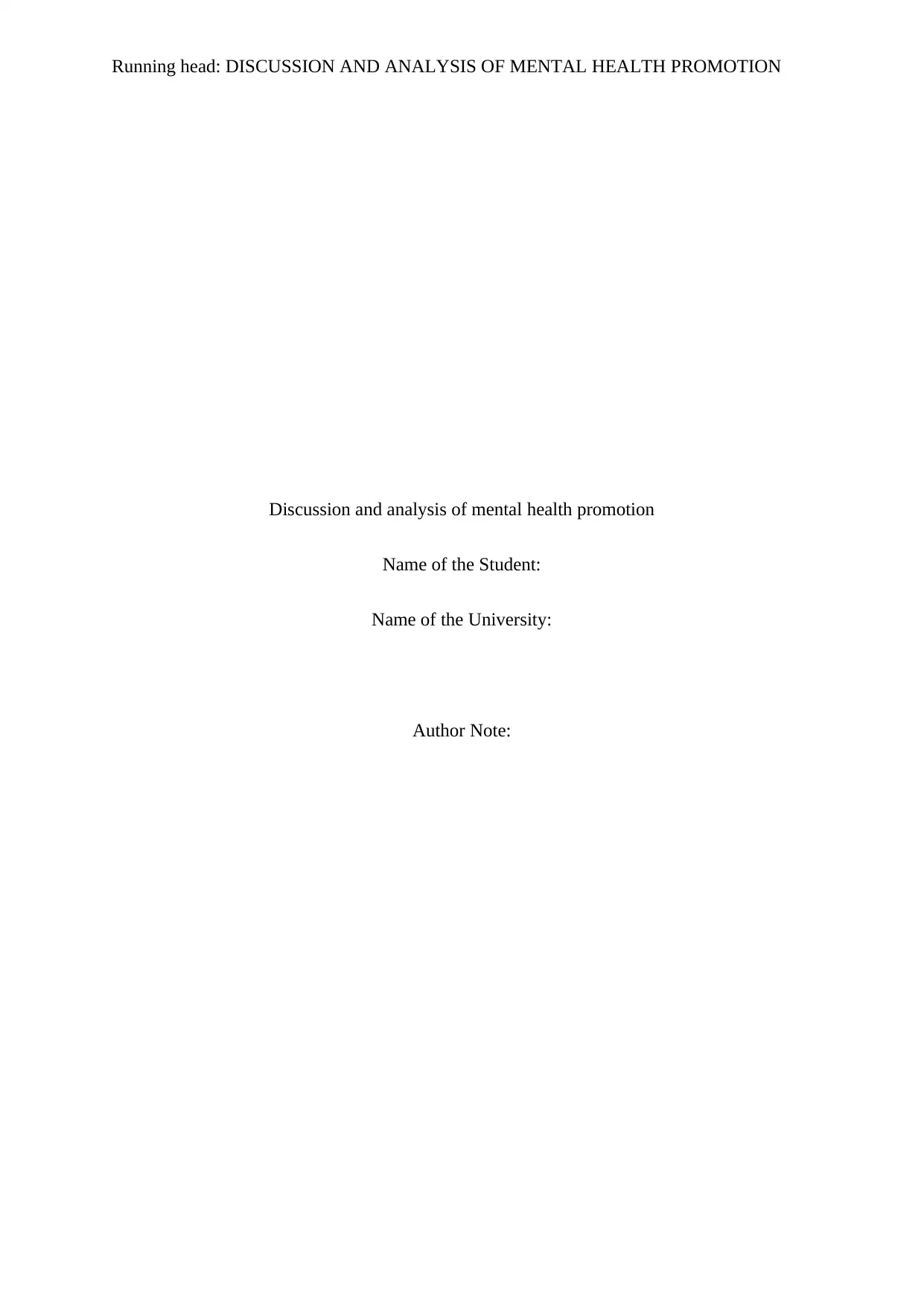
Running head: DISCUSSION AND ANALYSIS OF MENTAL HEALTH PROMOTION
Discussion and analysis of mental health promotion
Name of the Student:
Name of the University:
Author Note:
Discussion and analysis of mental health promotion
Name of the Student:
Name of the University:
Author Note:
Paraphrase This Document
Need a fresh take? Get an instant paraphrase of this document with our AI Paraphraser
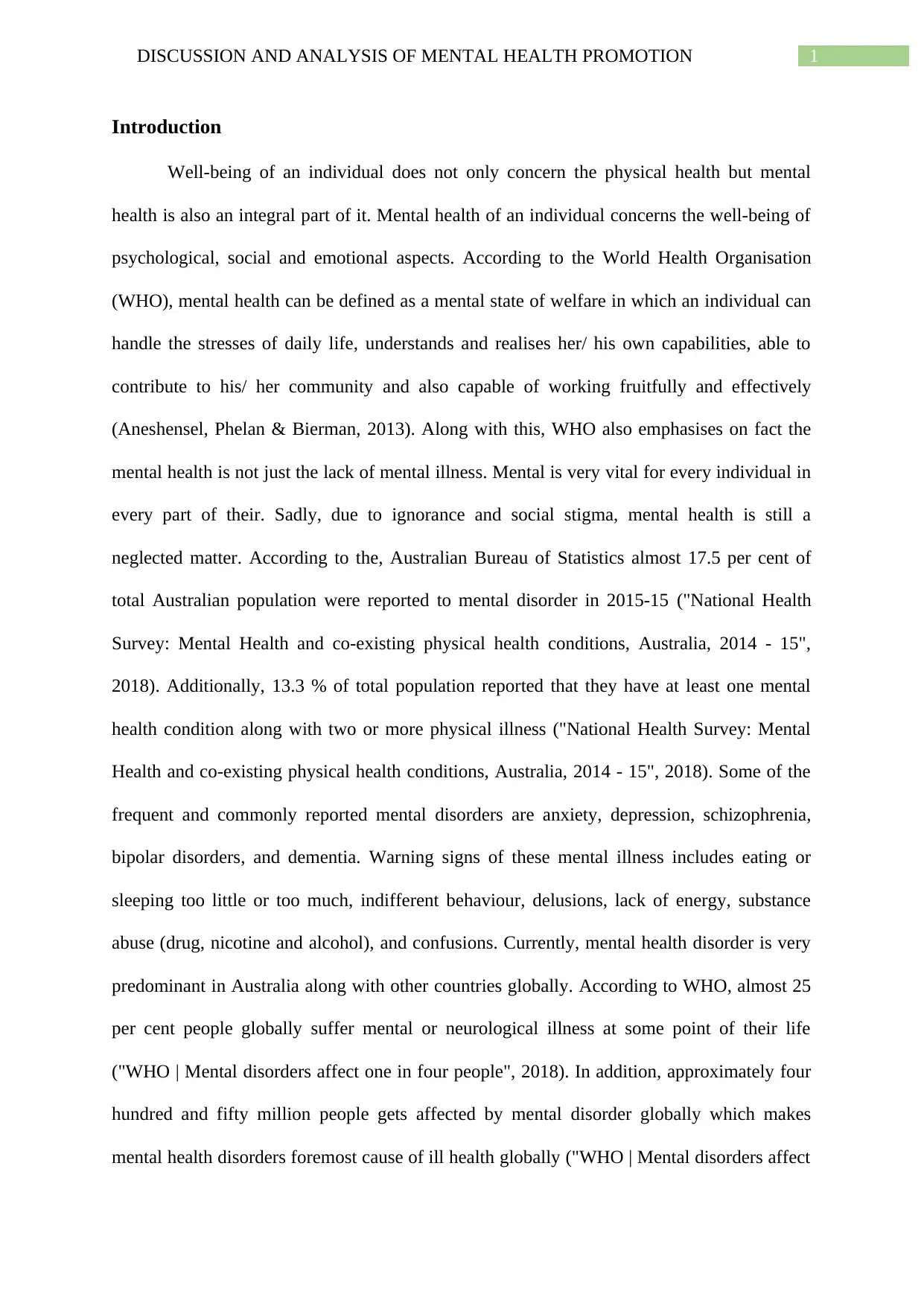
1DISCUSSION AND ANALYSIS OF MENTAL HEALTH PROMOTION
Introduction
Well-being of an individual does not only concern the physical health but mental
health is also an integral part of it. Mental health of an individual concerns the well-being of
psychological, social and emotional aspects. According to the World Health Organisation
(WHO), mental health can be defined as a mental state of welfare in which an individual can
handle the stresses of daily life, understands and realises her/ his own capabilities, able to
contribute to his/ her community and also capable of working fruitfully and effectively
(Aneshensel, Phelan & Bierman, 2013). Along with this, WHO also emphasises on fact the
mental health is not just the lack of mental illness. Mental is very vital for every individual in
every part of their. Sadly, due to ignorance and social stigma, mental health is still a
neglected matter. According to the, Australian Bureau of Statistics almost 17.5 per cent of
total Australian population were reported to mental disorder in 2015-15 ("National Health
Survey: Mental Health and co-existing physical health conditions, Australia, 2014 - 15",
2018). Additionally, 13.3 % of total population reported that they have at least one mental
health condition along with two or more physical illness ("National Health Survey: Mental
Health and co-existing physical health conditions, Australia, 2014 - 15", 2018). Some of the
frequent and commonly reported mental disorders are anxiety, depression, schizophrenia,
bipolar disorders, and dementia. Warning signs of these mental illness includes eating or
sleeping too little or too much, indifferent behaviour, delusions, lack of energy, substance
abuse (drug, nicotine and alcohol), and confusions. Currently, mental health disorder is very
predominant in Australia along with other countries globally. According to WHO, almost 25
per cent people globally suffer mental or neurological illness at some point of their life
("WHO | Mental disorders affect one in four people", 2018). In addition, approximately four
hundred and fifty million people gets affected by mental disorder globally which makes
mental health disorders foremost cause of ill health globally ("WHO | Mental disorders affect
Introduction
Well-being of an individual does not only concern the physical health but mental
health is also an integral part of it. Mental health of an individual concerns the well-being of
psychological, social and emotional aspects. According to the World Health Organisation
(WHO), mental health can be defined as a mental state of welfare in which an individual can
handle the stresses of daily life, understands and realises her/ his own capabilities, able to
contribute to his/ her community and also capable of working fruitfully and effectively
(Aneshensel, Phelan & Bierman, 2013). Along with this, WHO also emphasises on fact the
mental health is not just the lack of mental illness. Mental is very vital for every individual in
every part of their. Sadly, due to ignorance and social stigma, mental health is still a
neglected matter. According to the, Australian Bureau of Statistics almost 17.5 per cent of
total Australian population were reported to mental disorder in 2015-15 ("National Health
Survey: Mental Health and co-existing physical health conditions, Australia, 2014 - 15",
2018). Additionally, 13.3 % of total population reported that they have at least one mental
health condition along with two or more physical illness ("National Health Survey: Mental
Health and co-existing physical health conditions, Australia, 2014 - 15", 2018). Some of the
frequent and commonly reported mental disorders are anxiety, depression, schizophrenia,
bipolar disorders, and dementia. Warning signs of these mental illness includes eating or
sleeping too little or too much, indifferent behaviour, delusions, lack of energy, substance
abuse (drug, nicotine and alcohol), and confusions. Currently, mental health disorder is very
predominant in Australia along with other countries globally. According to WHO, almost 25
per cent people globally suffer mental or neurological illness at some point of their life
("WHO | Mental disorders affect one in four people", 2018). In addition, approximately four
hundred and fifty million people gets affected by mental disorder globally which makes
mental health disorders foremost cause of ill health globally ("WHO | Mental disorders affect
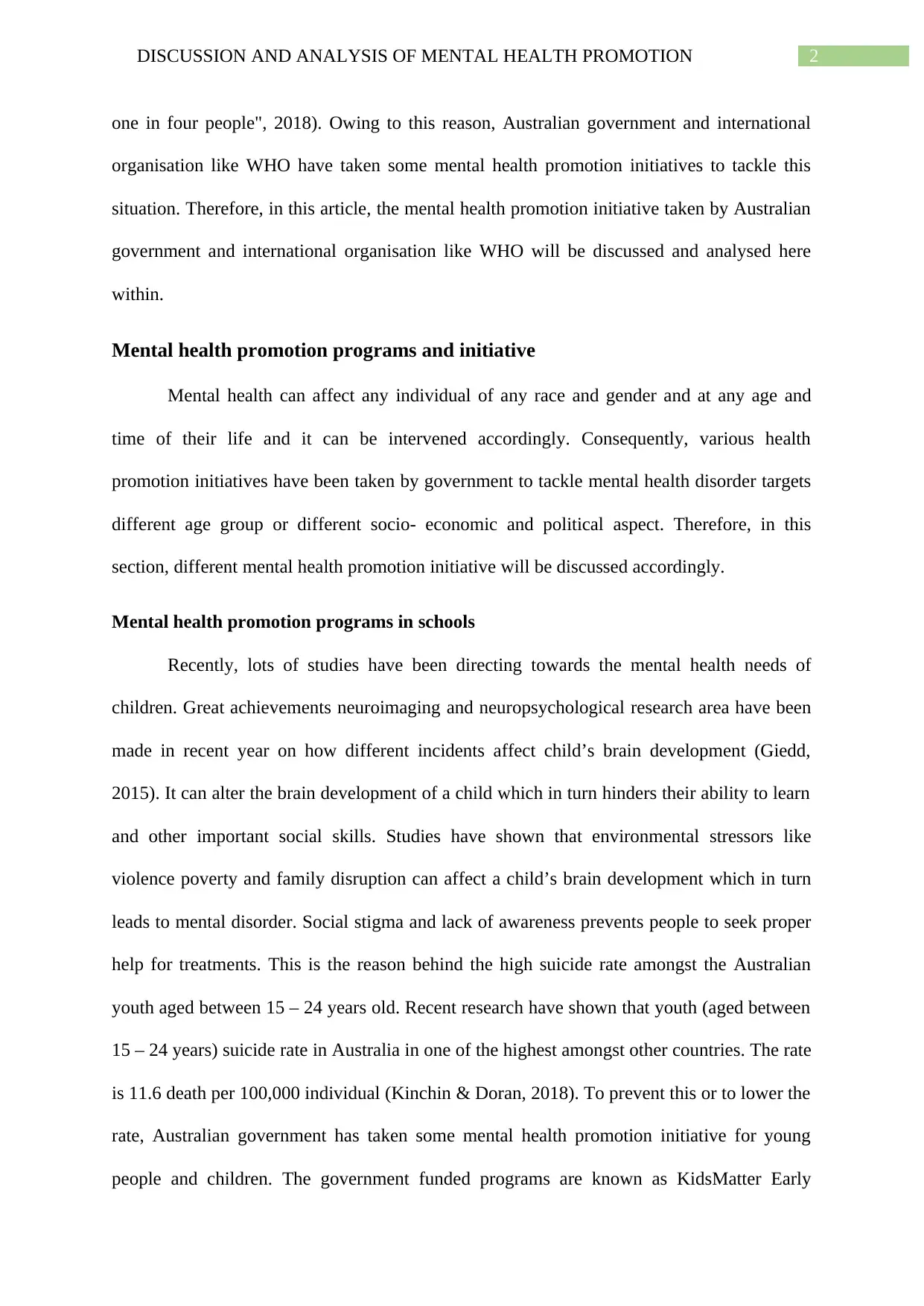
2DISCUSSION AND ANALYSIS OF MENTAL HEALTH PROMOTION
one in four people", 2018). Owing to this reason, Australian government and international
organisation like WHO have taken some mental health promotion initiatives to tackle this
situation. Therefore, in this article, the mental health promotion initiative taken by Australian
government and international organisation like WHO will be discussed and analysed here
within.
Mental health promotion programs and initiative
Mental health can affect any individual of any race and gender and at any age and
time of their life and it can be intervened accordingly. Consequently, various health
promotion initiatives have been taken by government to tackle mental health disorder targets
different age group or different socio- economic and political aspect. Therefore, in this
section, different mental health promotion initiative will be discussed accordingly.
Mental health promotion programs in schools
Recently, lots of studies have been directing towards the mental health needs of
children. Great achievements neuroimaging and neuropsychological research area have been
made in recent year on how different incidents affect child’s brain development (Giedd,
2015). It can alter the brain development of a child which in turn hinders their ability to learn
and other important social skills. Studies have shown that environmental stressors like
violence poverty and family disruption can affect a child’s brain development which in turn
leads to mental disorder. Social stigma and lack of awareness prevents people to seek proper
help for treatments. This is the reason behind the high suicide rate amongst the Australian
youth aged between 15 – 24 years old. Recent research have shown that youth (aged between
15 – 24 years) suicide rate in Australia in one of the highest amongst other countries. The rate
is 11.6 death per 100,000 individual (Kinchin & Doran, 2018). To prevent this or to lower the
rate, Australian government has taken some mental health promotion initiative for young
people and children. The government funded programs are known as KidsMatter Early
one in four people", 2018). Owing to this reason, Australian government and international
organisation like WHO have taken some mental health promotion initiatives to tackle this
situation. Therefore, in this article, the mental health promotion initiative taken by Australian
government and international organisation like WHO will be discussed and analysed here
within.
Mental health promotion programs and initiative
Mental health can affect any individual of any race and gender and at any age and
time of their life and it can be intervened accordingly. Consequently, various health
promotion initiatives have been taken by government to tackle mental health disorder targets
different age group or different socio- economic and political aspect. Therefore, in this
section, different mental health promotion initiative will be discussed accordingly.
Mental health promotion programs in schools
Recently, lots of studies have been directing towards the mental health needs of
children. Great achievements neuroimaging and neuropsychological research area have been
made in recent year on how different incidents affect child’s brain development (Giedd,
2015). It can alter the brain development of a child which in turn hinders their ability to learn
and other important social skills. Studies have shown that environmental stressors like
violence poverty and family disruption can affect a child’s brain development which in turn
leads to mental disorder. Social stigma and lack of awareness prevents people to seek proper
help for treatments. This is the reason behind the high suicide rate amongst the Australian
youth aged between 15 – 24 years old. Recent research have shown that youth (aged between
15 – 24 years) suicide rate in Australia in one of the highest amongst other countries. The rate
is 11.6 death per 100,000 individual (Kinchin & Doran, 2018). To prevent this or to lower the
rate, Australian government has taken some mental health promotion initiative for young
people and children. The government funded programs are known as KidsMatter Early
⊘ This is a preview!⊘
Do you want full access?
Subscribe today to unlock all pages.

Trusted by 1+ million students worldwide
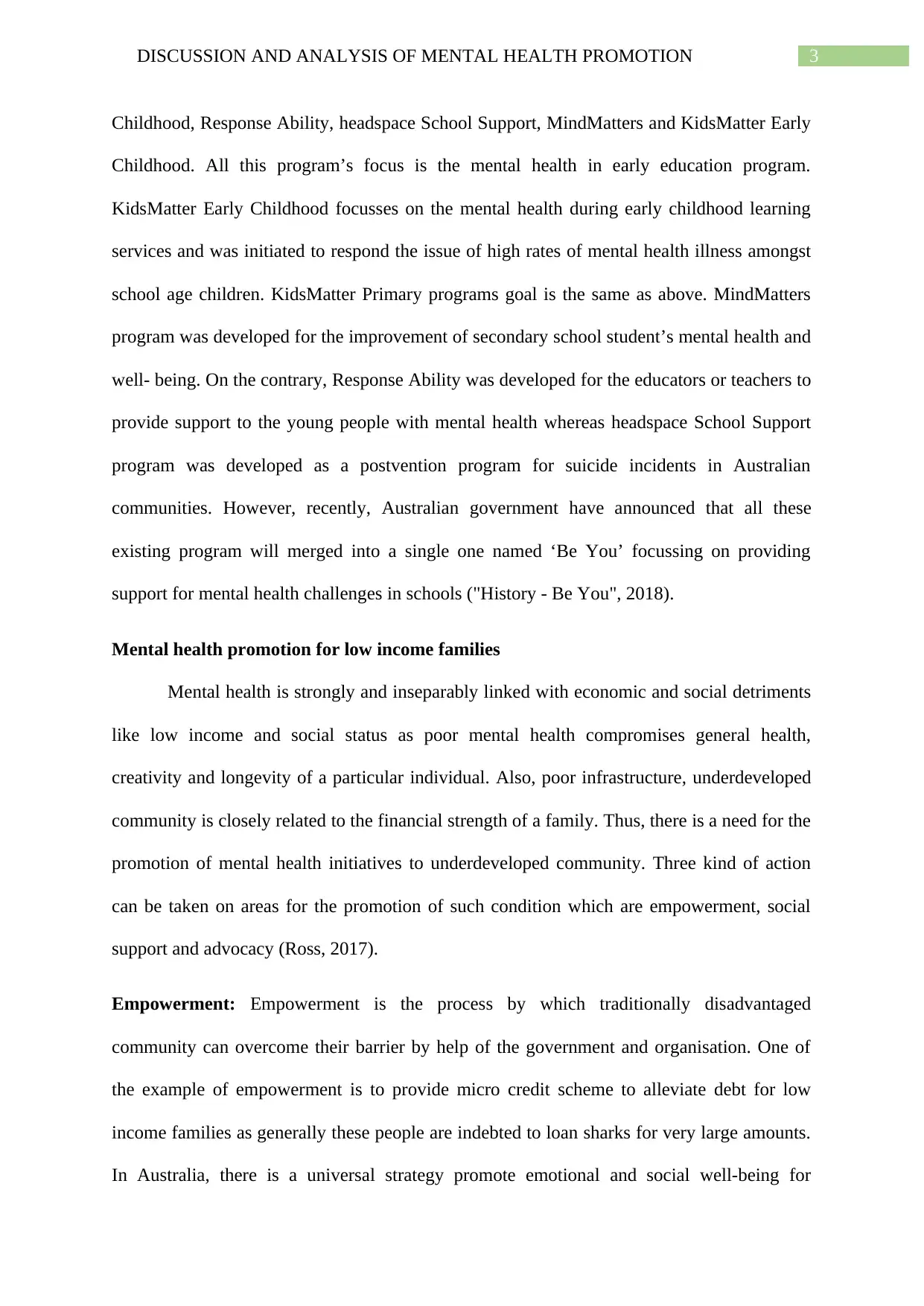
3DISCUSSION AND ANALYSIS OF MENTAL HEALTH PROMOTION
Childhood, Response Ability, headspace School Support, MindMatters and KidsMatter Early
Childhood. All this program’s focus is the mental health in early education program.
KidsMatter Early Childhood focusses on the mental health during early childhood learning
services and was initiated to respond the issue of high rates of mental health illness amongst
school age children. KidsMatter Primary programs goal is the same as above. MindMatters
program was developed for the improvement of secondary school student’s mental health and
well- being. On the contrary, Response Ability was developed for the educators or teachers to
provide support to the young people with mental health whereas headspace School Support
program was developed as a postvention program for suicide incidents in Australian
communities. However, recently, Australian government have announced that all these
existing program will merged into a single one named ‘Be You’ focussing on providing
support for mental health challenges in schools ("History - Be You", 2018).
Mental health promotion for low income families
Mental health is strongly and inseparably linked with economic and social detriments
like low income and social status as poor mental health compromises general health,
creativity and longevity of a particular individual. Also, poor infrastructure, underdeveloped
community is closely related to the financial strength of a family. Thus, there is a need for the
promotion of mental health initiatives to underdeveloped community. Three kind of action
can be taken on areas for the promotion of such condition which are empowerment, social
support and advocacy (Ross, 2017).
Empowerment: Empowerment is the process by which traditionally disadvantaged
community can overcome their barrier by help of the government and organisation. One of
the example of empowerment is to provide micro credit scheme to alleviate debt for low
income families as generally these people are indebted to loan sharks for very large amounts.
In Australia, there is a universal strategy promote emotional and social well-being for
Childhood, Response Ability, headspace School Support, MindMatters and KidsMatter Early
Childhood. All this program’s focus is the mental health in early education program.
KidsMatter Early Childhood focusses on the mental health during early childhood learning
services and was initiated to respond the issue of high rates of mental health illness amongst
school age children. KidsMatter Primary programs goal is the same as above. MindMatters
program was developed for the improvement of secondary school student’s mental health and
well- being. On the contrary, Response Ability was developed for the educators or teachers to
provide support to the young people with mental health whereas headspace School Support
program was developed as a postvention program for suicide incidents in Australian
communities. However, recently, Australian government have announced that all these
existing program will merged into a single one named ‘Be You’ focussing on providing
support for mental health challenges in schools ("History - Be You", 2018).
Mental health promotion for low income families
Mental health is strongly and inseparably linked with economic and social detriments
like low income and social status as poor mental health compromises general health,
creativity and longevity of a particular individual. Also, poor infrastructure, underdeveloped
community is closely related to the financial strength of a family. Thus, there is a need for the
promotion of mental health initiatives to underdeveloped community. Three kind of action
can be taken on areas for the promotion of such condition which are empowerment, social
support and advocacy (Ross, 2017).
Empowerment: Empowerment is the process by which traditionally disadvantaged
community can overcome their barrier by help of the government and organisation. One of
the example of empowerment is to provide micro credit scheme to alleviate debt for low
income families as generally these people are indebted to loan sharks for very large amounts.
In Australia, there is a universal strategy promote emotional and social well-being for
Paraphrase This Document
Need a fresh take? Get an instant paraphrase of this document with our AI Paraphraser
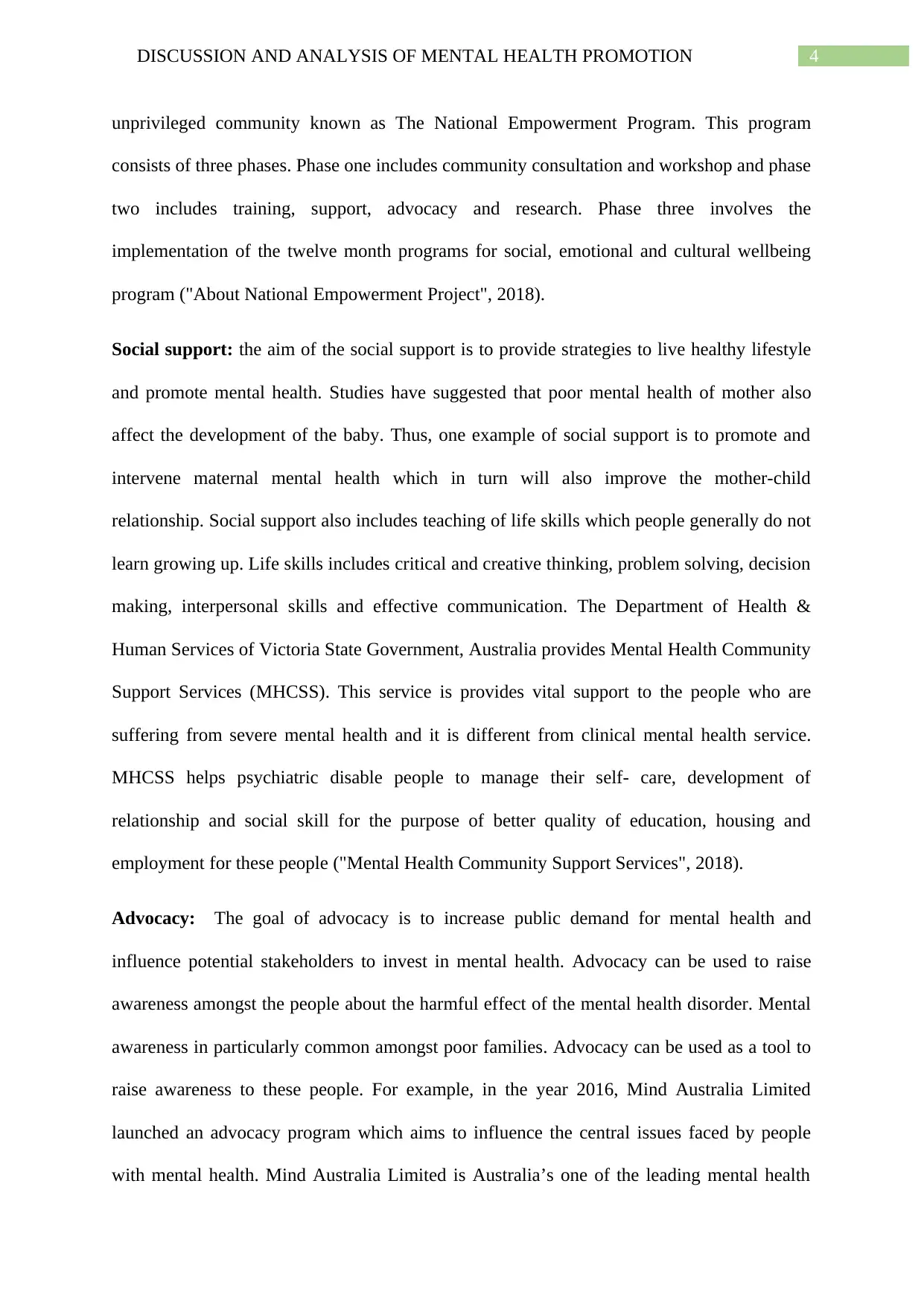
4DISCUSSION AND ANALYSIS OF MENTAL HEALTH PROMOTION
unprivileged community known as The National Empowerment Program. This program
consists of three phases. Phase one includes community consultation and workshop and phase
two includes training, support, advocacy and research. Phase three involves the
implementation of the twelve month programs for social, emotional and cultural wellbeing
program ("About National Empowerment Project", 2018).
Social support: the aim of the social support is to provide strategies to live healthy lifestyle
and promote mental health. Studies have suggested that poor mental health of mother also
affect the development of the baby. Thus, one example of social support is to promote and
intervene maternal mental health which in turn will also improve the mother-child
relationship. Social support also includes teaching of life skills which people generally do not
learn growing up. Life skills includes critical and creative thinking, problem solving, decision
making, interpersonal skills and effective communication. The Department of Health &
Human Services of Victoria State Government, Australia provides Mental Health Community
Support Services (MHCSS). This service is provides vital support to the people who are
suffering from severe mental health and it is different from clinical mental health service.
MHCSS helps psychiatric disable people to manage their self- care, development of
relationship and social skill for the purpose of better quality of education, housing and
employment for these people ("Mental Health Community Support Services", 2018).
Advocacy: The goal of advocacy is to increase public demand for mental health and
influence potential stakeholders to invest in mental health. Advocacy can be used to raise
awareness amongst the people about the harmful effect of the mental health disorder. Mental
awareness in particularly common amongst poor families. Advocacy can be used as a tool to
raise awareness to these people. For example, in the year 2016, Mind Australia Limited
launched an advocacy program which aims to influence the central issues faced by people
with mental health. Mind Australia Limited is Australia’s one of the leading mental health
unprivileged community known as The National Empowerment Program. This program
consists of three phases. Phase one includes community consultation and workshop and phase
two includes training, support, advocacy and research. Phase three involves the
implementation of the twelve month programs for social, emotional and cultural wellbeing
program ("About National Empowerment Project", 2018).
Social support: the aim of the social support is to provide strategies to live healthy lifestyle
and promote mental health. Studies have suggested that poor mental health of mother also
affect the development of the baby. Thus, one example of social support is to promote and
intervene maternal mental health which in turn will also improve the mother-child
relationship. Social support also includes teaching of life skills which people generally do not
learn growing up. Life skills includes critical and creative thinking, problem solving, decision
making, interpersonal skills and effective communication. The Department of Health &
Human Services of Victoria State Government, Australia provides Mental Health Community
Support Services (MHCSS). This service is provides vital support to the people who are
suffering from severe mental health and it is different from clinical mental health service.
MHCSS helps psychiatric disable people to manage their self- care, development of
relationship and social skill for the purpose of better quality of education, housing and
employment for these people ("Mental Health Community Support Services", 2018).
Advocacy: The goal of advocacy is to increase public demand for mental health and
influence potential stakeholders to invest in mental health. Advocacy can be used to raise
awareness amongst the people about the harmful effect of the mental health disorder. Mental
awareness in particularly common amongst poor families. Advocacy can be used as a tool to
raise awareness to these people. For example, in the year 2016, Mind Australia Limited
launched an advocacy program which aims to influence the central issues faced by people
with mental health. Mind Australia Limited is Australia’s one of the leading mental health
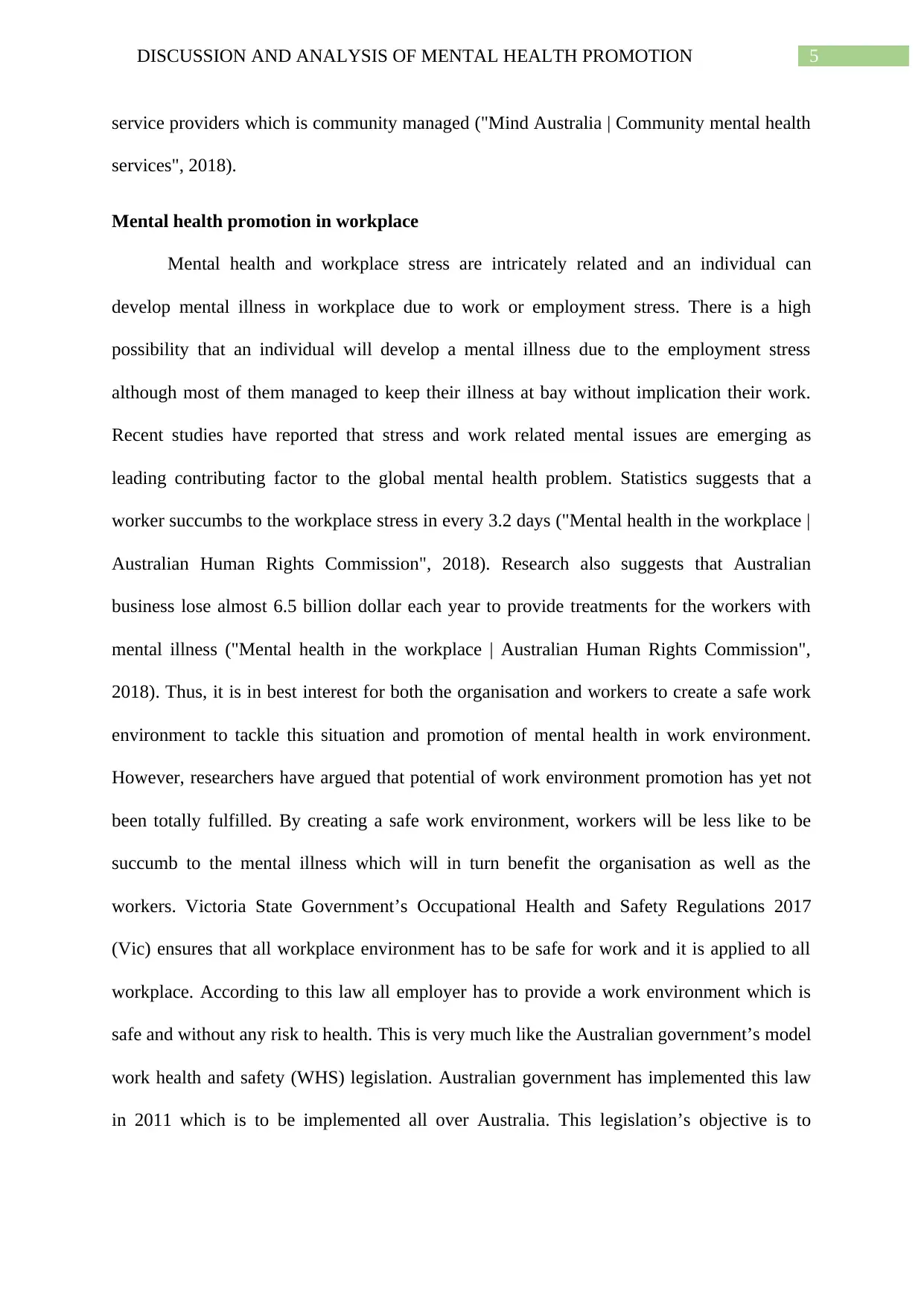
5DISCUSSION AND ANALYSIS OF MENTAL HEALTH PROMOTION
service providers which is community managed ("Mind Australia | Community mental health
services", 2018).
Mental health promotion in workplace
Mental health and workplace stress are intricately related and an individual can
develop mental illness in workplace due to work or employment stress. There is a high
possibility that an individual will develop a mental illness due to the employment stress
although most of them managed to keep their illness at bay without implication their work.
Recent studies have reported that stress and work related mental issues are emerging as
leading contributing factor to the global mental health problem. Statistics suggests that a
worker succumbs to the workplace stress in every 3.2 days ("Mental health in the workplace |
Australian Human Rights Commission", 2018). Research also suggests that Australian
business lose almost 6.5 billion dollar each year to provide treatments for the workers with
mental illness ("Mental health in the workplace | Australian Human Rights Commission",
2018). Thus, it is in best interest for both the organisation and workers to create a safe work
environment to tackle this situation and promotion of mental health in work environment.
However, researchers have argued that potential of work environment promotion has yet not
been totally fulfilled. By creating a safe work environment, workers will be less like to be
succumb to the mental illness which will in turn benefit the organisation as well as the
workers. Victoria State Government’s Occupational Health and Safety Regulations 2017
(Vic) ensures that all workplace environment has to be safe for work and it is applied to all
workplace. According to this law all employer has to provide a work environment which is
safe and without any risk to health. This is very much like the Australian government’s model
work health and safety (WHS) legislation. Australian government has implemented this law
in 2011 which is to be implemented all over Australia. This legislation’s objective is to
service providers which is community managed ("Mind Australia | Community mental health
services", 2018).
Mental health promotion in workplace
Mental health and workplace stress are intricately related and an individual can
develop mental illness in workplace due to work or employment stress. There is a high
possibility that an individual will develop a mental illness due to the employment stress
although most of them managed to keep their illness at bay without implication their work.
Recent studies have reported that stress and work related mental issues are emerging as
leading contributing factor to the global mental health problem. Statistics suggests that a
worker succumbs to the workplace stress in every 3.2 days ("Mental health in the workplace |
Australian Human Rights Commission", 2018). Research also suggests that Australian
business lose almost 6.5 billion dollar each year to provide treatments for the workers with
mental illness ("Mental health in the workplace | Australian Human Rights Commission",
2018). Thus, it is in best interest for both the organisation and workers to create a safe work
environment to tackle this situation and promotion of mental health in work environment.
However, researchers have argued that potential of work environment promotion has yet not
been totally fulfilled. By creating a safe work environment, workers will be less like to be
succumb to the mental illness which will in turn benefit the organisation as well as the
workers. Victoria State Government’s Occupational Health and Safety Regulations 2017
(Vic) ensures that all workplace environment has to be safe for work and it is applied to all
workplace. According to this law all employer has to provide a work environment which is
safe and without any risk to health. This is very much like the Australian government’s model
work health and safety (WHS) legislation. Australian government has implemented this law
in 2011 which is to be implemented all over Australia. This legislation’s objective is to
⊘ This is a preview!⊘
Do you want full access?
Subscribe today to unlock all pages.

Trusted by 1+ million students worldwide
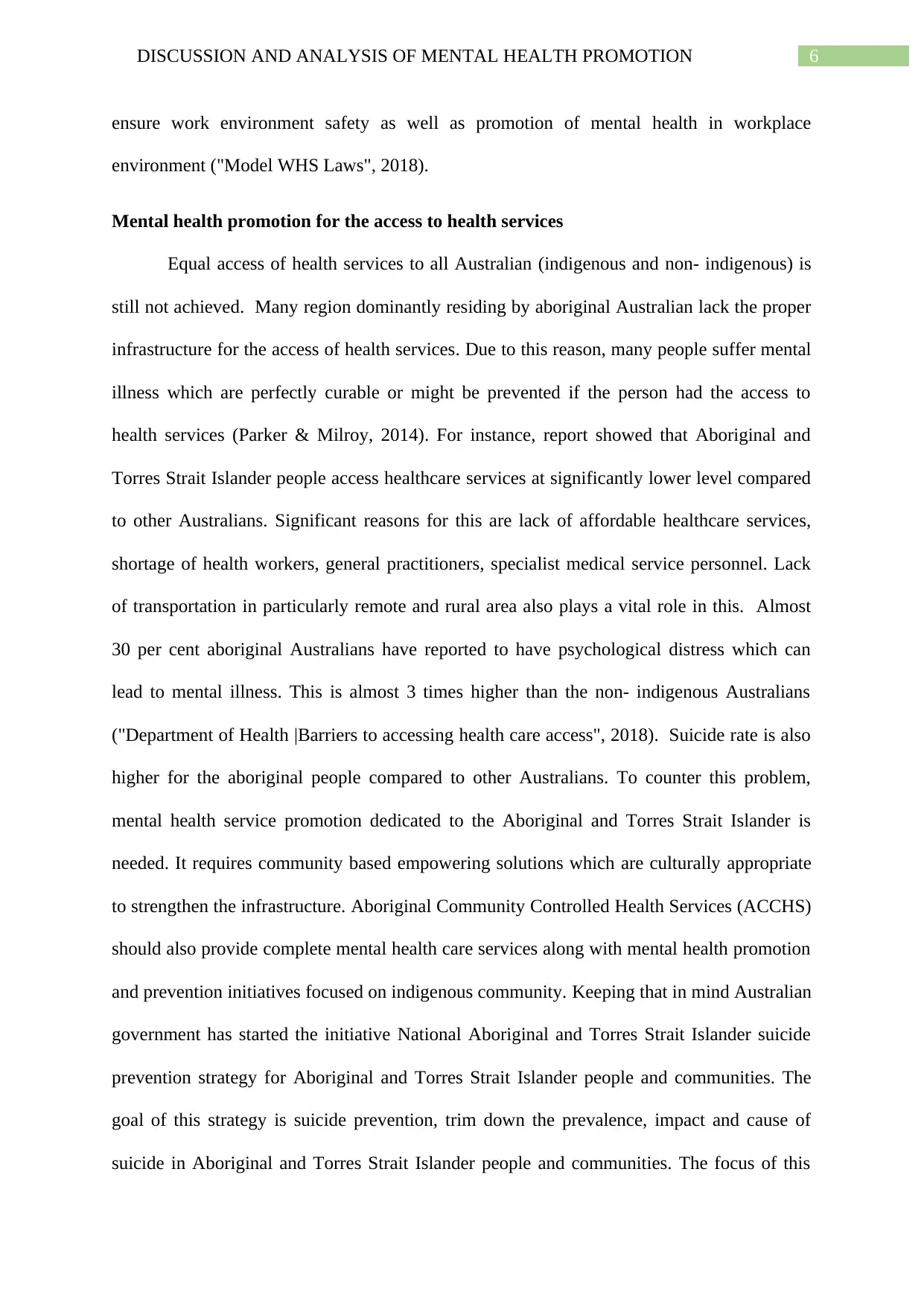
6DISCUSSION AND ANALYSIS OF MENTAL HEALTH PROMOTION
ensure work environment safety as well as promotion of mental health in workplace
environment ("Model WHS Laws", 2018).
Mental health promotion for the access to health services
Equal access of health services to all Australian (indigenous and non- indigenous) is
still not achieved. Many region dominantly residing by aboriginal Australian lack the proper
infrastructure for the access of health services. Due to this reason, many people suffer mental
illness which are perfectly curable or might be prevented if the person had the access to
health services (Parker & Milroy, 2014). For instance, report showed that Aboriginal and
Torres Strait Islander people access healthcare services at significantly lower level compared
to other Australians. Significant reasons for this are lack of affordable healthcare services,
shortage of health workers, general practitioners, specialist medical service personnel. Lack
of transportation in particularly remote and rural area also plays a vital role in this. Almost
30 per cent aboriginal Australians have reported to have psychological distress which can
lead to mental illness. This is almost 3 times higher than the non- indigenous Australians
("Department of Health |Barriers to accessing health care access", 2018). Suicide rate is also
higher for the aboriginal people compared to other Australians. To counter this problem,
mental health service promotion dedicated to the Aboriginal and Torres Strait Islander is
needed. It requires community based empowering solutions which are culturally appropriate
to strengthen the infrastructure. Aboriginal Community Controlled Health Services (ACCHS)
should also provide complete mental health care services along with mental health promotion
and prevention initiatives focused on indigenous community. Keeping that in mind Australian
government has started the initiative National Aboriginal and Torres Strait Islander suicide
prevention strategy for Aboriginal and Torres Strait Islander people and communities. The
goal of this strategy is suicide prevention, trim down the prevalence, impact and cause of
suicide in Aboriginal and Torres Strait Islander people and communities. The focus of this
ensure work environment safety as well as promotion of mental health in workplace
environment ("Model WHS Laws", 2018).
Mental health promotion for the access to health services
Equal access of health services to all Australian (indigenous and non- indigenous) is
still not achieved. Many region dominantly residing by aboriginal Australian lack the proper
infrastructure for the access of health services. Due to this reason, many people suffer mental
illness which are perfectly curable or might be prevented if the person had the access to
health services (Parker & Milroy, 2014). For instance, report showed that Aboriginal and
Torres Strait Islander people access healthcare services at significantly lower level compared
to other Australians. Significant reasons for this are lack of affordable healthcare services,
shortage of health workers, general practitioners, specialist medical service personnel. Lack
of transportation in particularly remote and rural area also plays a vital role in this. Almost
30 per cent aboriginal Australians have reported to have psychological distress which can
lead to mental illness. This is almost 3 times higher than the non- indigenous Australians
("Department of Health |Barriers to accessing health care access", 2018). Suicide rate is also
higher for the aboriginal people compared to other Australians. To counter this problem,
mental health service promotion dedicated to the Aboriginal and Torres Strait Islander is
needed. It requires community based empowering solutions which are culturally appropriate
to strengthen the infrastructure. Aboriginal Community Controlled Health Services (ACCHS)
should also provide complete mental health care services along with mental health promotion
and prevention initiatives focused on indigenous community. Keeping that in mind Australian
government has started the initiative National Aboriginal and Torres Strait Islander suicide
prevention strategy for Aboriginal and Torres Strait Islander people and communities. The
goal of this strategy is suicide prevention, trim down the prevalence, impact and cause of
suicide in Aboriginal and Torres Strait Islander people and communities. The focus of this
Paraphrase This Document
Need a fresh take? Get an instant paraphrase of this document with our AI Paraphraser
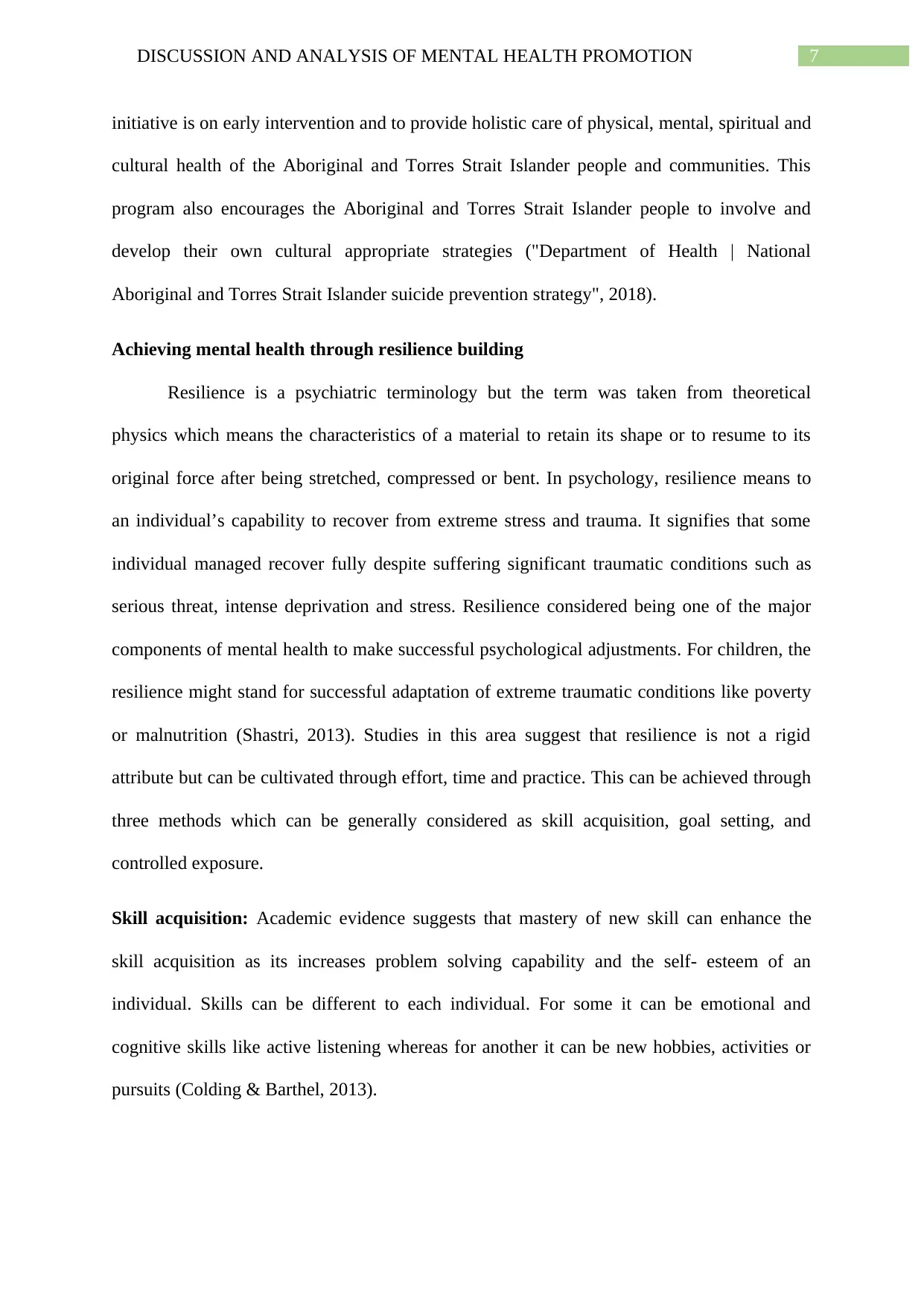
7DISCUSSION AND ANALYSIS OF MENTAL HEALTH PROMOTION
initiative is on early intervention and to provide holistic care of physical, mental, spiritual and
cultural health of the Aboriginal and Torres Strait Islander people and communities. This
program also encourages the Aboriginal and Torres Strait Islander people to involve and
develop their own cultural appropriate strategies ("Department of Health | National
Aboriginal and Torres Strait Islander suicide prevention strategy", 2018).
Achieving mental health through resilience building
Resilience is a psychiatric terminology but the term was taken from theoretical
physics which means the characteristics of a material to retain its shape or to resume to its
original force after being stretched, compressed or bent. In psychology, resilience means to
an individual’s capability to recover from extreme stress and trauma. It signifies that some
individual managed recover fully despite suffering significant traumatic conditions such as
serious threat, intense deprivation and stress. Resilience considered being one of the major
components of mental health to make successful psychological adjustments. For children, the
resilience might stand for successful adaptation of extreme traumatic conditions like poverty
or malnutrition (Shastri, 2013). Studies in this area suggest that resilience is not a rigid
attribute but can be cultivated through effort, time and practice. This can be achieved through
three methods which can be generally considered as skill acquisition, goal setting, and
controlled exposure.
Skill acquisition: Academic evidence suggests that mastery of new skill can enhance the
skill acquisition as its increases problem solving capability and the self- esteem of an
individual. Skills can be different to each individual. For some it can be emotional and
cognitive skills like active listening whereas for another it can be new hobbies, activities or
pursuits (Colding & Barthel, 2013).
initiative is on early intervention and to provide holistic care of physical, mental, spiritual and
cultural health of the Aboriginal and Torres Strait Islander people and communities. This
program also encourages the Aboriginal and Torres Strait Islander people to involve and
develop their own cultural appropriate strategies ("Department of Health | National
Aboriginal and Torres Strait Islander suicide prevention strategy", 2018).
Achieving mental health through resilience building
Resilience is a psychiatric terminology but the term was taken from theoretical
physics which means the characteristics of a material to retain its shape or to resume to its
original force after being stretched, compressed or bent. In psychology, resilience means to
an individual’s capability to recover from extreme stress and trauma. It signifies that some
individual managed recover fully despite suffering significant traumatic conditions such as
serious threat, intense deprivation and stress. Resilience considered being one of the major
components of mental health to make successful psychological adjustments. For children, the
resilience might stand for successful adaptation of extreme traumatic conditions like poverty
or malnutrition (Shastri, 2013). Studies in this area suggest that resilience is not a rigid
attribute but can be cultivated through effort, time and practice. This can be achieved through
three methods which can be generally considered as skill acquisition, goal setting, and
controlled exposure.
Skill acquisition: Academic evidence suggests that mastery of new skill can enhance the
skill acquisition as its increases problem solving capability and the self- esteem of an
individual. Skills can be different to each individual. For some it can be emotional and
cognitive skills like active listening whereas for another it can be new hobbies, activities or
pursuits (Colding & Barthel, 2013).
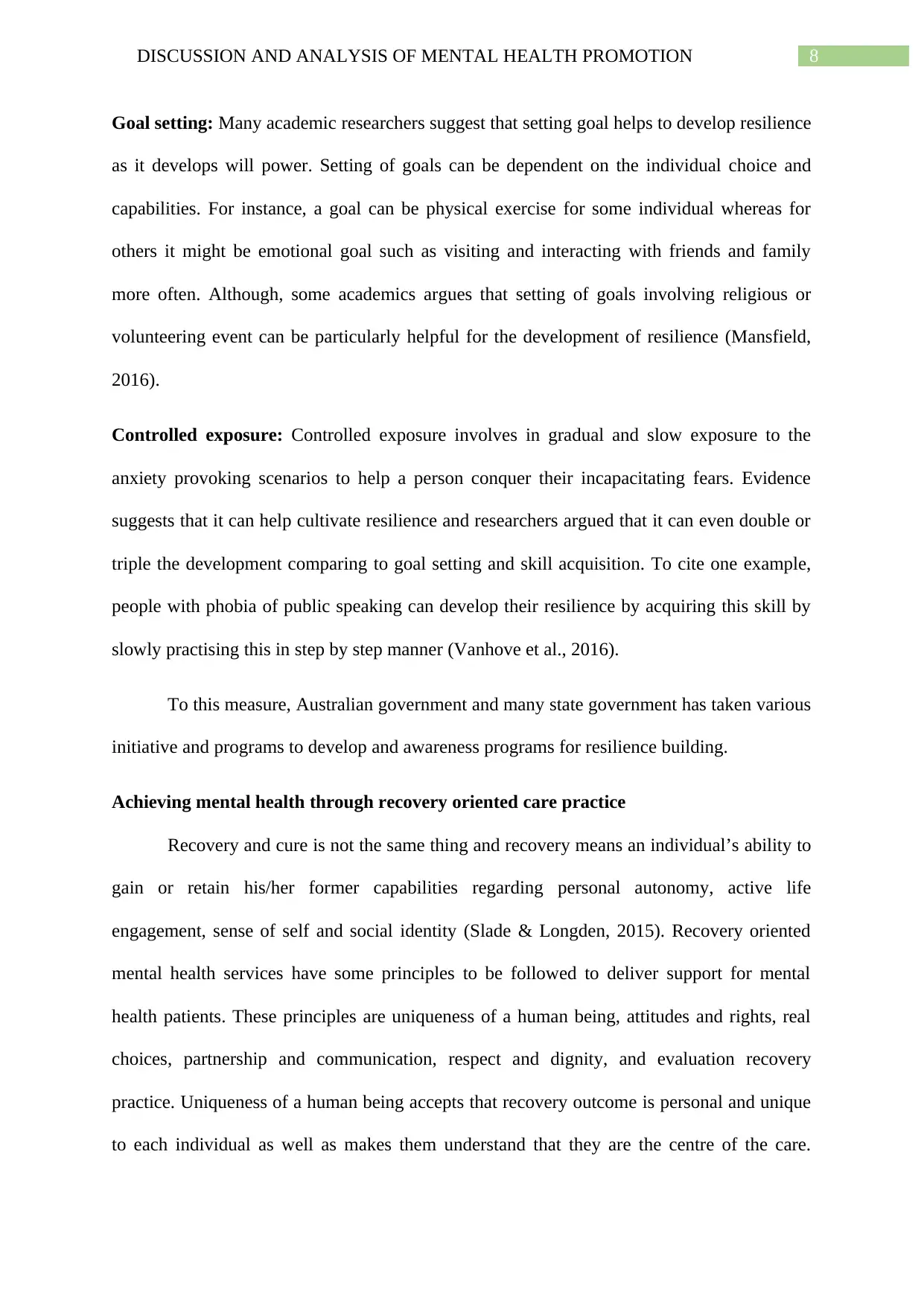
8DISCUSSION AND ANALYSIS OF MENTAL HEALTH PROMOTION
Goal setting: Many academic researchers suggest that setting goal helps to develop resilience
as it develops will power. Setting of goals can be dependent on the individual choice and
capabilities. For instance, a goal can be physical exercise for some individual whereas for
others it might be emotional goal such as visiting and interacting with friends and family
more often. Although, some academics argues that setting of goals involving religious or
volunteering event can be particularly helpful for the development of resilience (Mansfield,
2016).
Controlled exposure: Controlled exposure involves in gradual and slow exposure to the
anxiety provoking scenarios to help a person conquer their incapacitating fears. Evidence
suggests that it can help cultivate resilience and researchers argued that it can even double or
triple the development comparing to goal setting and skill acquisition. To cite one example,
people with phobia of public speaking can develop their resilience by acquiring this skill by
slowly practising this in step by step manner (Vanhove et al., 2016).
To this measure, Australian government and many state government has taken various
initiative and programs to develop and awareness programs for resilience building.
Achieving mental health through recovery oriented care practice
Recovery and cure is not the same thing and recovery means an individual’s ability to
gain or retain his/her former capabilities regarding personal autonomy, active life
engagement, sense of self and social identity (Slade & Longden, 2015). Recovery oriented
mental health services have some principles to be followed to deliver support for mental
health patients. These principles are uniqueness of a human being, attitudes and rights, real
choices, partnership and communication, respect and dignity, and evaluation recovery
practice. Uniqueness of a human being accepts that recovery outcome is personal and unique
to each individual as well as makes them understand that they are the centre of the care.
Goal setting: Many academic researchers suggest that setting goal helps to develop resilience
as it develops will power. Setting of goals can be dependent on the individual choice and
capabilities. For instance, a goal can be physical exercise for some individual whereas for
others it might be emotional goal such as visiting and interacting with friends and family
more often. Although, some academics argues that setting of goals involving religious or
volunteering event can be particularly helpful for the development of resilience (Mansfield,
2016).
Controlled exposure: Controlled exposure involves in gradual and slow exposure to the
anxiety provoking scenarios to help a person conquer their incapacitating fears. Evidence
suggests that it can help cultivate resilience and researchers argued that it can even double or
triple the development comparing to goal setting and skill acquisition. To cite one example,
people with phobia of public speaking can develop their resilience by acquiring this skill by
slowly practising this in step by step manner (Vanhove et al., 2016).
To this measure, Australian government and many state government has taken various
initiative and programs to develop and awareness programs for resilience building.
Achieving mental health through recovery oriented care practice
Recovery and cure is not the same thing and recovery means an individual’s ability to
gain or retain his/her former capabilities regarding personal autonomy, active life
engagement, sense of self and social identity (Slade & Longden, 2015). Recovery oriented
mental health services have some principles to be followed to deliver support for mental
health patients. These principles are uniqueness of a human being, attitudes and rights, real
choices, partnership and communication, respect and dignity, and evaluation recovery
practice. Uniqueness of a human being accepts that recovery outcome is personal and unique
to each individual as well as makes them understand that they are the centre of the care.
⊘ This is a preview!⊘
Do you want full access?
Subscribe today to unlock all pages.

Trusted by 1+ million students worldwide
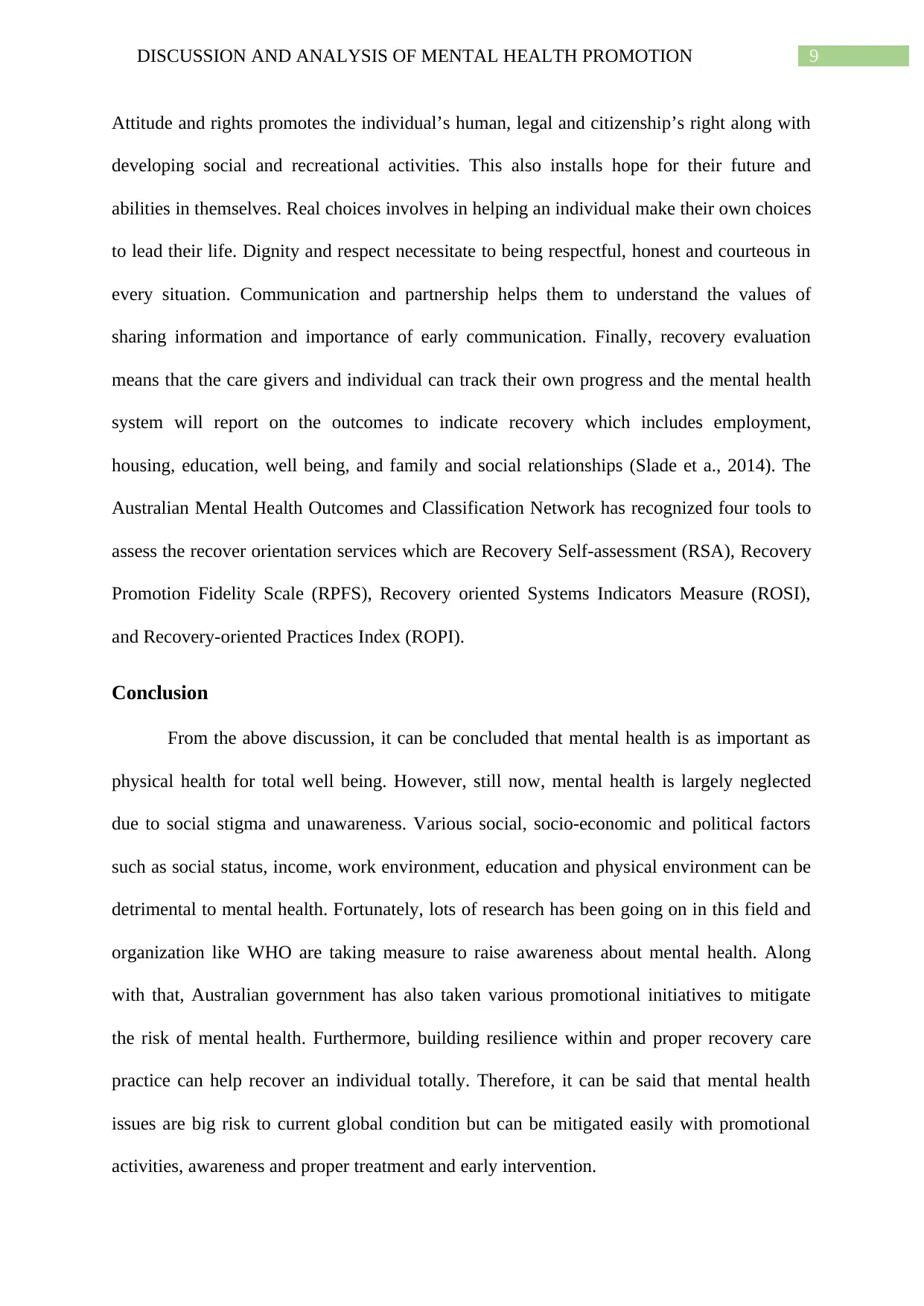
9DISCUSSION AND ANALYSIS OF MENTAL HEALTH PROMOTION
Attitude and rights promotes the individual’s human, legal and citizenship’s right along with
developing social and recreational activities. This also installs hope for their future and
abilities in themselves. Real choices involves in helping an individual make their own choices
to lead their life. Dignity and respect necessitate to being respectful, honest and courteous in
every situation. Communication and partnership helps them to understand the values of
sharing information and importance of early communication. Finally, recovery evaluation
means that the care givers and individual can track their own progress and the mental health
system will report on the outcomes to indicate recovery which includes employment,
housing, education, well being, and family and social relationships (Slade et a., 2014). The
Australian Mental Health Outcomes and Classification Network has recognized four tools to
assess the recover orientation services which are Recovery Self-assessment (RSA), Recovery
Promotion Fidelity Scale (RPFS), Recovery oriented Systems Indicators Measure (ROSI),
and Recovery-oriented Practices Index (ROPI).
Conclusion
From the above discussion, it can be concluded that mental health is as important as
physical health for total well being. However, still now, mental health is largely neglected
due to social stigma and unawareness. Various social, socio-economic and political factors
such as social status, income, work environment, education and physical environment can be
detrimental to mental health. Fortunately, lots of research has been going on in this field and
organization like WHO are taking measure to raise awareness about mental health. Along
with that, Australian government has also taken various promotional initiatives to mitigate
the risk of mental health. Furthermore, building resilience within and proper recovery care
practice can help recover an individual totally. Therefore, it can be said that mental health
issues are big risk to current global condition but can be mitigated easily with promotional
activities, awareness and proper treatment and early intervention.
Attitude and rights promotes the individual’s human, legal and citizenship’s right along with
developing social and recreational activities. This also installs hope for their future and
abilities in themselves. Real choices involves in helping an individual make their own choices
to lead their life. Dignity and respect necessitate to being respectful, honest and courteous in
every situation. Communication and partnership helps them to understand the values of
sharing information and importance of early communication. Finally, recovery evaluation
means that the care givers and individual can track their own progress and the mental health
system will report on the outcomes to indicate recovery which includes employment,
housing, education, well being, and family and social relationships (Slade et a., 2014). The
Australian Mental Health Outcomes and Classification Network has recognized four tools to
assess the recover orientation services which are Recovery Self-assessment (RSA), Recovery
Promotion Fidelity Scale (RPFS), Recovery oriented Systems Indicators Measure (ROSI),
and Recovery-oriented Practices Index (ROPI).
Conclusion
From the above discussion, it can be concluded that mental health is as important as
physical health for total well being. However, still now, mental health is largely neglected
due to social stigma and unawareness. Various social, socio-economic and political factors
such as social status, income, work environment, education and physical environment can be
detrimental to mental health. Fortunately, lots of research has been going on in this field and
organization like WHO are taking measure to raise awareness about mental health. Along
with that, Australian government has also taken various promotional initiatives to mitigate
the risk of mental health. Furthermore, building resilience within and proper recovery care
practice can help recover an individual totally. Therefore, it can be said that mental health
issues are big risk to current global condition but can be mitigated easily with promotional
activities, awareness and proper treatment and early intervention.
Paraphrase This Document
Need a fresh take? Get an instant paraphrase of this document with our AI Paraphraser
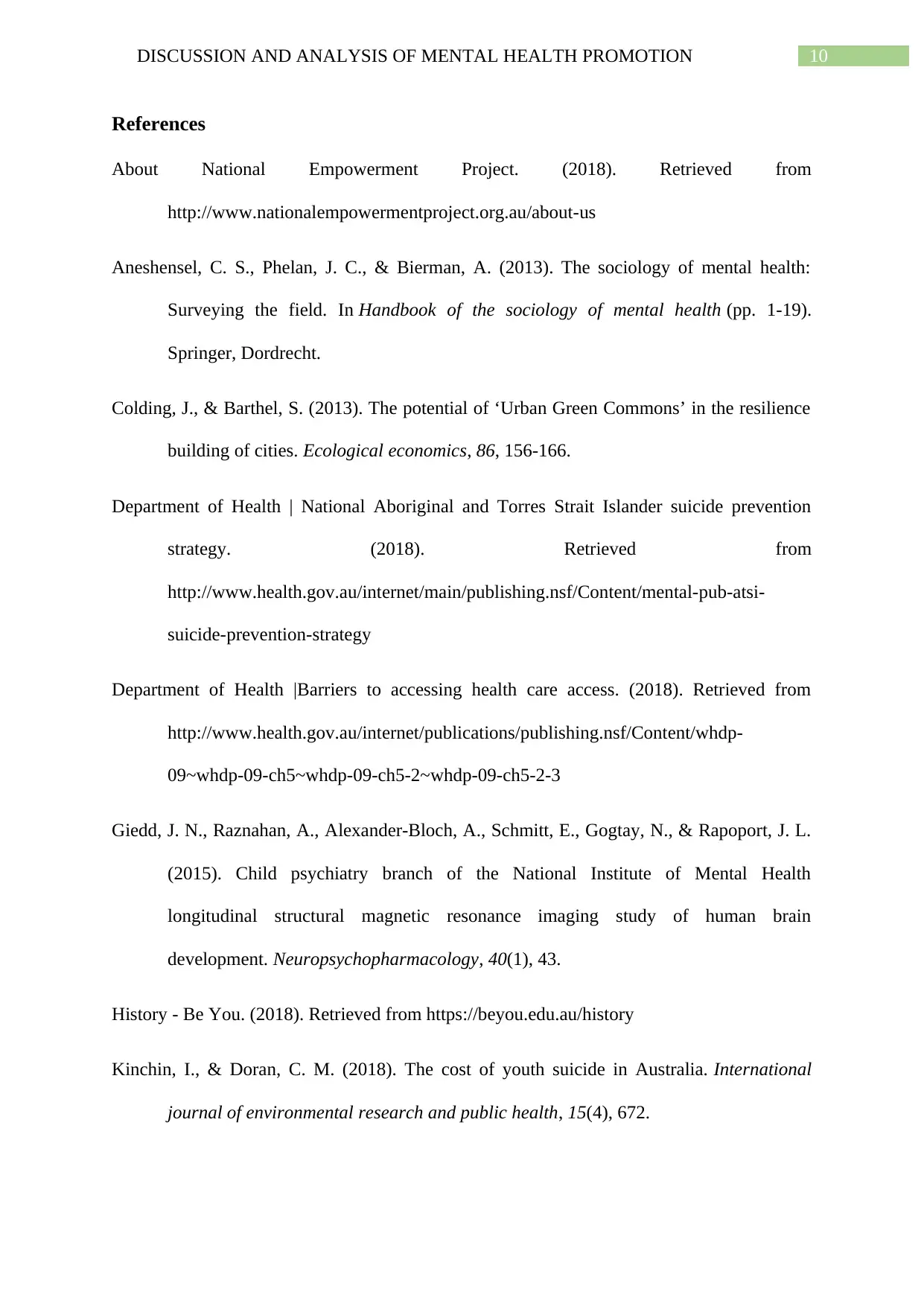
10DISCUSSION AND ANALYSIS OF MENTAL HEALTH PROMOTION
References
About National Empowerment Project. (2018). Retrieved from
http://www.nationalempowermentproject.org.au/about-us
Aneshensel, C. S., Phelan, J. C., & Bierman, A. (2013). The sociology of mental health:
Surveying the field. In Handbook of the sociology of mental health (pp. 1-19).
Springer, Dordrecht.
Colding, J., & Barthel, S. (2013). The potential of ‘Urban Green Commons’ in the resilience
building of cities. Ecological economics, 86, 156-166.
Department of Health | National Aboriginal and Torres Strait Islander suicide prevention
strategy. (2018). Retrieved from
http://www.health.gov.au/internet/main/publishing.nsf/Content/mental-pub-atsi-
suicide-prevention-strategy
Department of Health |Barriers to accessing health care access. (2018). Retrieved from
http://www.health.gov.au/internet/publications/publishing.nsf/Content/whdp-
09~whdp-09-ch5~whdp-09-ch5-2~whdp-09-ch5-2-3
Giedd, J. N., Raznahan, A., Alexander-Bloch, A., Schmitt, E., Gogtay, N., & Rapoport, J. L.
(2015). Child psychiatry branch of the National Institute of Mental Health
longitudinal structural magnetic resonance imaging study of human brain
development. Neuropsychopharmacology, 40(1), 43.
History - Be You. (2018). Retrieved from https://beyou.edu.au/history
Kinchin, I., & Doran, C. M. (2018). The cost of youth suicide in Australia. International
journal of environmental research and public health, 15(4), 672.
References
About National Empowerment Project. (2018). Retrieved from
http://www.nationalempowermentproject.org.au/about-us
Aneshensel, C. S., Phelan, J. C., & Bierman, A. (2013). The sociology of mental health:
Surveying the field. In Handbook of the sociology of mental health (pp. 1-19).
Springer, Dordrecht.
Colding, J., & Barthel, S. (2013). The potential of ‘Urban Green Commons’ in the resilience
building of cities. Ecological economics, 86, 156-166.
Department of Health | National Aboriginal and Torres Strait Islander suicide prevention
strategy. (2018). Retrieved from
http://www.health.gov.au/internet/main/publishing.nsf/Content/mental-pub-atsi-
suicide-prevention-strategy
Department of Health |Barriers to accessing health care access. (2018). Retrieved from
http://www.health.gov.au/internet/publications/publishing.nsf/Content/whdp-
09~whdp-09-ch5~whdp-09-ch5-2~whdp-09-ch5-2-3
Giedd, J. N., Raznahan, A., Alexander-Bloch, A., Schmitt, E., Gogtay, N., & Rapoport, J. L.
(2015). Child psychiatry branch of the National Institute of Mental Health
longitudinal structural magnetic resonance imaging study of human brain
development. Neuropsychopharmacology, 40(1), 43.
History - Be You. (2018). Retrieved from https://beyou.edu.au/history
Kinchin, I., & Doran, C. M. (2018). The cost of youth suicide in Australia. International
journal of environmental research and public health, 15(4), 672.
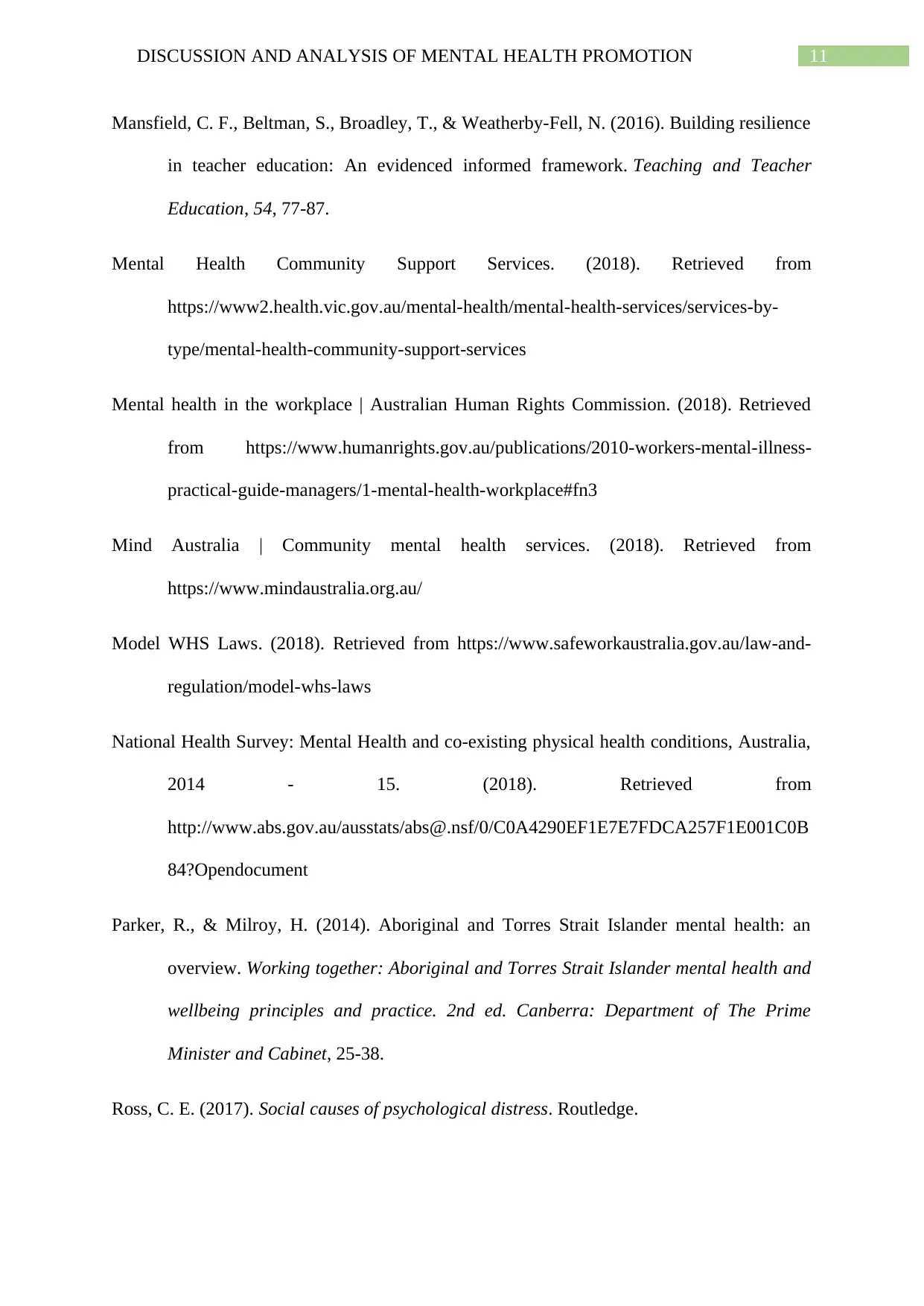
11DISCUSSION AND ANALYSIS OF MENTAL HEALTH PROMOTION
Mansfield, C. F., Beltman, S., Broadley, T., & Weatherby-Fell, N. (2016). Building resilience
in teacher education: An evidenced informed framework. Teaching and Teacher
Education, 54, 77-87.
Mental Health Community Support Services. (2018). Retrieved from
https://www2.health.vic.gov.au/mental-health/mental-health-services/services-by-
type/mental-health-community-support-services
Mental health in the workplace | Australian Human Rights Commission. (2018). Retrieved
from https://www.humanrights.gov.au/publications/2010-workers-mental-illness-
practical-guide-managers/1-mental-health-workplace#fn3
Mind Australia | Community mental health services. (2018). Retrieved from
https://www.mindaustralia.org.au/
Model WHS Laws. (2018). Retrieved from https://www.safeworkaustralia.gov.au/law-and-
regulation/model-whs-laws
National Health Survey: Mental Health and co-existing physical health conditions, Australia,
2014 - 15. (2018). Retrieved from
http://www.abs.gov.au/ausstats/abs@.nsf/0/C0A4290EF1E7E7FDCA257F1E001C0B
84?Opendocument
Parker, R., & Milroy, H. (2014). Aboriginal and Torres Strait Islander mental health: an
overview. Working together: Aboriginal and Torres Strait Islander mental health and
wellbeing principles and practice. 2nd ed. Canberra: Department of The Prime
Minister and Cabinet, 25-38.
Ross, C. E. (2017). Social causes of psychological distress. Routledge.
Mansfield, C. F., Beltman, S., Broadley, T., & Weatherby-Fell, N. (2016). Building resilience
in teacher education: An evidenced informed framework. Teaching and Teacher
Education, 54, 77-87.
Mental Health Community Support Services. (2018). Retrieved from
https://www2.health.vic.gov.au/mental-health/mental-health-services/services-by-
type/mental-health-community-support-services
Mental health in the workplace | Australian Human Rights Commission. (2018). Retrieved
from https://www.humanrights.gov.au/publications/2010-workers-mental-illness-
practical-guide-managers/1-mental-health-workplace#fn3
Mind Australia | Community mental health services. (2018). Retrieved from
https://www.mindaustralia.org.au/
Model WHS Laws. (2018). Retrieved from https://www.safeworkaustralia.gov.au/law-and-
regulation/model-whs-laws
National Health Survey: Mental Health and co-existing physical health conditions, Australia,
2014 - 15. (2018). Retrieved from
http://www.abs.gov.au/ausstats/abs@.nsf/0/C0A4290EF1E7E7FDCA257F1E001C0B
84?Opendocument
Parker, R., & Milroy, H. (2014). Aboriginal and Torres Strait Islander mental health: an
overview. Working together: Aboriginal and Torres Strait Islander mental health and
wellbeing principles and practice. 2nd ed. Canberra: Department of The Prime
Minister and Cabinet, 25-38.
Ross, C. E. (2017). Social causes of psychological distress. Routledge.
⊘ This is a preview!⊘
Do you want full access?
Subscribe today to unlock all pages.

Trusted by 1+ million students worldwide
1 out of 13
Related Documents
Your All-in-One AI-Powered Toolkit for Academic Success.
+13062052269
info@desklib.com
Available 24*7 on WhatsApp / Email
![[object Object]](/_next/static/media/star-bottom.7253800d.svg)
Unlock your academic potential
Copyright © 2020–2025 A2Z Services. All Rights Reserved. Developed and managed by ZUCOL.





